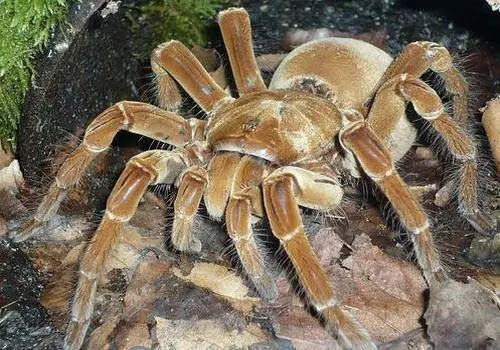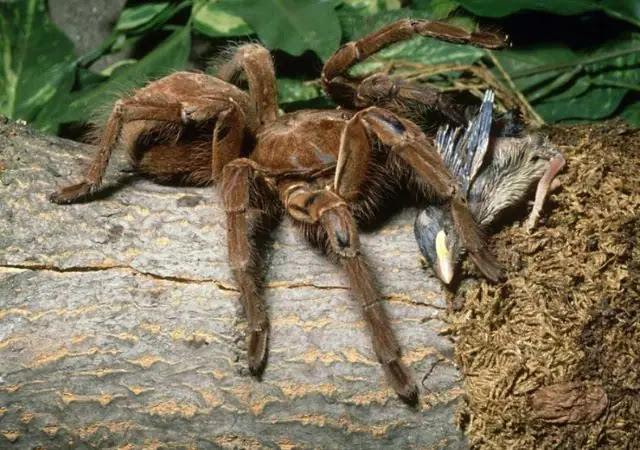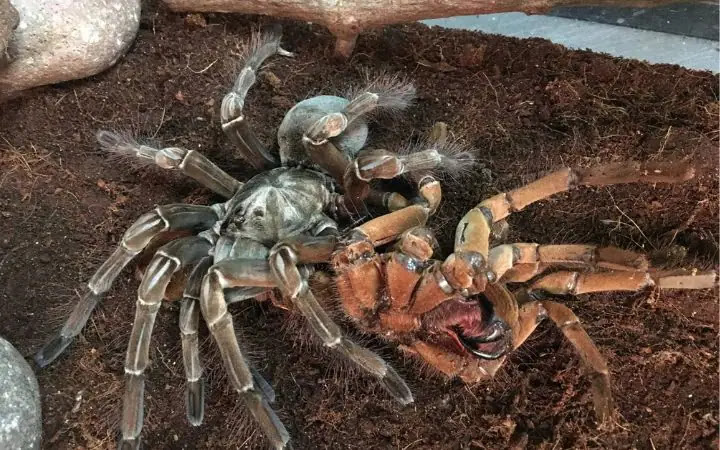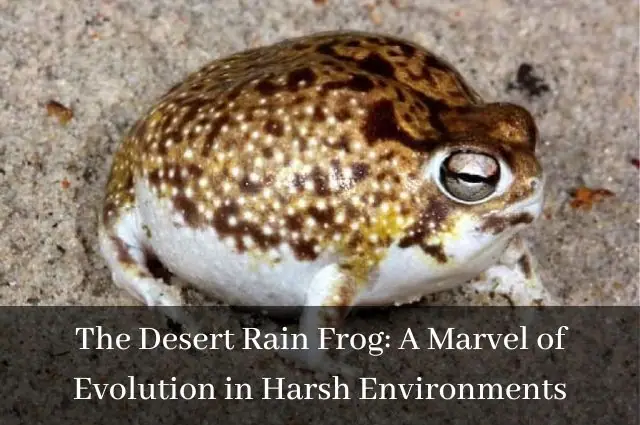The World’s Largest Spider Goliath Birdeater

The Goliath Birdeater, scientifically known as Theraphosa blondi, is the largest spider in the world by mass and size, belonging to the tarantula family Theraphosidae. These spiders are native to the rainforests of South America, particularly in the countries of Brazil, Venezuela, and Suriname.
These spiders can grow up to a leg span of 30 centimeters (12 inches) and can weigh as much as 170 grams (6 ounces), making them a formidable predators in their habitat. They have hairy bodies that range in color from dark brown to black, and their legs have distinctive pinkish-orange rings.
Despite their intimidating size, Goliath Birdeaters are generally not aggressive toward humans, and their venom is not lethal to people. They are primarily nocturnal, spending their days in burrows that they dig in the ground, and emerge at night to hunt for prey, which includes insects, small mammals, and even snakes.
One of the most fascinating aspects of these spiders is their ability to defend themselves. When threatened, they can release tiny barbed hairs from their abdomen, which can cause severe irritation and itching if they come into contact with skin or eyes. In addition, they can also produce a hissing sound by rubbing their legs together, which serves as a warning to potential predators.
Overall, the Bird-Eating Tarantula is a fascinating and impressive creature, read on to learn more about this biggest spider.
All About The Goliath Birdeater
Appearance and Behavior
Goliath Birdeaters have hairy bodies that range from dark brown to black, and their legs have distinctive pinkish-orange rings. Despite their intimidating appearance, Goliath Birdeaters are not generally aggressive toward humans, and their venom is not lethal to people.
Goliath Birdeaters are primarily nocturnal, spending their days in burrows that they dig in the ground, and emerge at night to hunt for prey, which includes insects, small mammals, and even snakes.
One of the most fascinating aspects of these spiders is their ability to defend themselves. When threatened, they can release tiny barbed hairs from their abdomen, which can cause severe irritation and itching if they come into contact with skin or eyes.
In addition, they can also produce a hissing sound by rubbing their legs together, which serves as a warning to potential predators.
Goliath Birdeaters are solitary creatures, and while they do not actively seek out confrontation with humans, they should be treated with respect and caution. It’s important to remember that they are still wild animals, and can be dangerous if provoked or mishandled.
.
Habitat

The Goliath Birdeater is native to the rainforests of South America, particularly in the countries of Brazil, Venezuela, and Suriname. They are typically found on the forest floor, where they dig deep burrows for shelter and protection.
These spiders prefer humid environments, and can often be found in areas with high levels of rainfall and moisture. They are well-adapted to their rainforest habitat and are able to thrive in the dense vegetation and complex ecosystems of the region.
However, habitat loss and deforestation are significant threats to the survival of Goliath Birdeaters, as they rely on intact rainforest ecosystems to provide food, shelter, and protection. The destruction of their habitat has led to a decline in their numbers, and they are now considered a vulnerable species.
.
Diet and Predators

The Goliath Birdeater is a carnivorous spider that feeds on a variety of prey, including insects, small mammals, amphibians, reptiles, and even other spiders. They are opportunistic hunters and will eat whatever prey is available to them in their environment.
Despite their large size and impressive defenses, Goliath Birdeaters do have some natural predators. Young spiders may be preyed upon by other spiders, while larger individuals may be taken by birds, small mammals, or reptiles. However, due to their formidable size and ability to defend themselves, predators tend to avoid these spiders whenever possible.
It’s worth noting that the Goliath Birdeater’s name is somewhat misleading, as they do not typically prey on birds. While they have been observed eating small birds in the wild, these are rare and not a significant part of their diet.
Lastly, the Goliath Birdeater is a top predator in its rainforest habitat, and its diet and defenses play an important role in maintaining the balance of the ecosystem.
.
Defense System

The Goliath Birdeater has several defense systems that it uses to protect itself from predators or threats. Here are some of its most notable defense systems.
#1. Hissing
When threatened or disturbed, the Goliath Birdeater can produce a hissing sound by rubbing its legs together or by forcing air out of its spiracles. This can intimidate predators and may serve as a warning before the spider resorts to more aggressive defensive measures.
#2. Flicking Urts
The Goliath Birdeater has specialized hairs on its abdomen called “urticating hairs” that it can flick off as a defense mechanism. These hairs are barbed and can cause irritation or inflammation to the skin, eyes, or respiratory tract of a predator or perceived threat.
#3. Biting
If threatened or cornered, the Goliath Birdeater may resort to biting as a defensive measure. Although its venom is not lethal to humans, the bite can be painful and may cause swelling or other symptoms.
#4. Camouflage
The Goliath Birdeater has excellent camouflage abilities and can blend in with its surroundings to avoid detection or predators.
It’s worth noting that the Goliath Birdeater is a generally docile spider and will only resort to defensive measures if it feels threatened or provoked. It’s important to handle this spider with care and respect and to avoid provoking or disturbing it unnecessarily.
.
Reproduction Process
The reproduction process of the Goliath Birdeater is a fascinating and complex process that involves courtship rituals and mating behaviors.
Males typically reach sexual maturity at around 5-7 years of age, while females can take up to 10 years to mature. When a male is ready to mate, he will search for a female and attempt to attract her with a series of tapping and drumming motions on the ground and on the female’s burrow.
If the female is receptive, she will allow the male to approach and mate with her. The actual mating process can last several hours, during which the male will transfer his sperm to the female using specialized appendages on his body called pedipalps.
After mating, the female will lay a clutch of eggs, which can number in the hundreds. She will then guard and protect the eggs until they hatch, which can take several weeks to several months, depending on environmental conditions.
Once the eggs hatch, the young spiderlings will remain with the female for a period of time, feeding on yolk reserves until they are large enough to hunt on their own. Female Goliath Birdeaters can live up to 25 years in the wild, while males typically have a shorter lifespan of 3-6 years.
Overall, the reproduction process of the Goliath Birdeater is a complex and fascinating process that allows these spiders to continue their species in their rainforest habitat.
.
Housing
#1. Preferred Temperature
The Goliath Birdeater is a tropical species and prefers warm and humid conditions. The optimal temperature range for a Goliath Birdeater enclosure is between 75-85°F (24-29°C). Temperatures outside of this range can cause stress or health problems for the spider.
To maintain the preferred temperature range, a heat source such as a heat mat, ceramic heat emitter, or heat lamp can be used. It’s important to provide a temperature gradient within the enclosure, with a warmer area and a cooler area, to allow the spider to regulate its body temperature.
The enclosure should also be kept humid, with a humidity level of around 70-80%. This can be achieved by misting the enclosure regularly, providing a water dish, and using a substrate that retains moisture.
#2. Soil
The Goliath Birdeater requires a substrate that can hold moisture but also provides good drainage to prevent waterlogging. A mixture of peat moss, coconut coir, and vermiculite can be used as a suitable substrate for this spider.
The substrate should be kept moist but not too wet, as excess moisture can lead to fungal growth and bacterial infections. It’s important to provide a water dish for the spider to drink from and to maintain the humidity level within the enclosure.
Some spider keepers also add leaf litter or other natural materials to the substrate to provide a more naturalistic environment for the spider. It’s important to avoid using substrates that contain pesticides, chemicals, or other harmful substances, as these can be toxic to the spider.
.
Lifespan

The Goliath Birdeater (Theraphosa blondi) is one of the largest species of spider in the world and can be found in the rainforests of South America. The lifespan of a Goliath Birdeater can vary depending on various factors such as gender, diet, and habitat.
Females tend to live longer than males, with females living up to 25 years in captivity, while males typically only live up to 3-6 years. In the wild, their lifespan is likely to be shorter due to various environmental factors such as predation, disease, and habitat destruction.
It’s worth noting that the lifespan of a Goliath Birdeater in captivity can be extended with proper care, nutrition, and housing conditions. However, keeping a Goliath Birdeater as a pet is not recommended for everyone, as they are large and potentially dangerous spiders.
FAQs:
1. What does the goliath Birdeater eat?
The World’s largest spider is the Goliath birdeater, which is known to eat a variety of prey including insects, rodents, small birds, and even snakes. They are opportunistic feeders and are capable of subduing prey that is several times their size.
2. Can a Goliath Birdeater eat a bird?
While the Goliath Birdeater spider is capable of catching and eating small birds, it is not a regular part of their diet. The name “Birdeater” can be misleading, as they do not exclusively feed on birds, nor are they, specialized bird predators. In the wild, these spiders feed mainly on invertebrates such as insects, other spiders, and occasionally small vertebrates such as rodents or lizards.
3. Where does the goliath spider live?
The Goliath Birdeater spider (Theraphosa blondi) is native to the rainforests of South America, specifically the countries of Brazil, Suriname, Guyana, and Venezuela. They inhabit a range of forested habitats, including the Amazon rainforest, and can be found on the forest floor, in tree trunks, or in burrows that they dig themselves.
4. Can a goliath Birdeater kill you?
While the Goliath Birdeater spider is the largest spider in the world and has a fearsome appearance, it is not considered to be a significant threat to humans. Like most spiders, the Goliath Birdeater has venom, but its bite is not fatal to humans. While a bite from a Goliath Birdeater can cause localized pain and swelling, as well as possible allergic reactions in some individuals.
Read Also:






